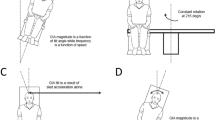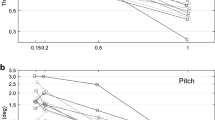Abstract
The otolith organs respond equivalently to changes in gravitational force due to head tilt and to changes in inertial force due to linear acceleration. It has been shown that the central nervous system (CNS) uses internal models of the laws of physics to distinguish tilt from translation. Models with these internal models predict that illusory tilt, if large enough, will be accompanied by an illusion of linear motion. To investigate this prediction, we measured interaural, self-motion, direction-detection thresholds in darkness and with roll optokinetic stimulation. Each lateral translation consisted of a single cycle of sinusoidal acceleration, after which subjects indicated whether they translated to the left or right. We found that the interaural direction-detection threshold measured during clockwise and counterclockwise optokinetic stimulation shifted in opposite directions relative to thresholds in darkness. Using a generalized linear model, we determined that this finding was statistically significant (P < 0.005) and is consistent with the prediction that illusory tilt should be accompanied by a non-zero neural estimate of linear velocity that, if large enough (supra-threshold), contributes to translation perception.


Similar content being viewed by others
Notes
All bold quantities designate three-dimensional vectors in a head-fixed frame of reference.
The simulations were performed using an unmodified version of Zupan’s model—not even a single parameter was changed.
We report findings in units of velocity. Because relationships between peak acceleration, peak velocity, and total displacement are linear, findings—including statistics—would be unchanged if data were rescaled to units consistent with peak acceleration magnitude or total displacement.
References
Angelaki DE, McHenry MQ, Dickman JD, Newlands SD, Hess BJM (1999) Computation of inertial motion: neural strategies to resolve ambiguous otolith information. J Neurosci 19:316–327
Angelaki DE, Shaikh AG, Green AM, Dickman JD (2004) Neurons compute internal models of the physical laws of motion. Nature 430:560–564
Benson AJ, Spencer MB, Stott JR (1986) Thresholds for the detection of the direction of whole-body, linear movement in the horizontal plane. Aviat Space Environ Med 57:1088–1096
Collett D (1991) Modeling binary data. Chapman and Hall, London
Dichgans J, Held R, Young LR, Brandt T (1972) Moving visual scenes influence the apparent direction of gravity. Science 178:1217–1219
Droulez J, Darlot C (1989) The geometric and dynamic implications of the coherence constraints in three-dimensional sensorimotor interactions. In: Jeannerod M (ed) Attention and performance XIII. Erlbaum, New York, pp 495–526
Glasauer S (1992) Interaction of semicircular canals and otoliths in the processing structure of the subjective zenith. Ann N Y Acad Sci 656:847–849
Grabherr L, Nicoucar K, Mast F, Merfeld D (2008) Vestibular thresholds for yaw rotation about an earth-vertical axis as a function of frequency. Exp Brain Res 186:677–681
Jones GM, Young LR (1978) Subjective detection of vertical acceleration: a velocity-dependent response? Acta Otolaryngol 85:45–53
McCullagh P, Nelder JA (1983) Generalized linear models. Chapman and Hall, London
Merfeld DM (1995) Modeling the vestibulo-ocular reflex of the squirrel monkey during eccentric rotation and roll tilt. Exp Brain Res 106:123–134
Merfeld DM, Park S, Gianna-Poulin C, Black FO, Wood S (2005a) Vestibular perception and action employ qualitatively different mechanisms. I. Frequency response of VOR and perceptual responses during Translation and Tilt. J Neurophysiol 94:186–198
Merfeld DM, Park S, Gianna-Poulin C, Black FO, Wood S (2005b) Vestibular perception and action employ qualitatively different mechanisms. II. VOR and perceptual responses during combined Tilt&Translation. J Neurophysiol 94:199–205
Merfeld DM, Young L, Oman C, Shelhamer M (1993) A multi-dimensional model of the effect of gravity on the spatial orientation of the monkey. J Ves Res 3:141–161
Merfeld DM, Young LR (1995) The vestibulo-ocular reflex of the squirrel monkey during eccentric rotation and roll tilt. Exp Brain Res 106:111–122
Merfeld DM, Young LR, Tomko D (1990) Spatial orientation of VOR to vestibular stimuli in squirrel monkeys (Abstract). In: Barany Society, Tokyo, Japan
Merfeld DM, Zupan L, Peterka RJ (1999) Humans use an internal model to separate gravity and linear acceleration. Nature 398:615–618
Merfeld DM, Zupan LH (2002) Neural processing of gravito-inertial cues in humans. III. Modeling tilt and translation responses. J Neurophysiol 87:819–833
Merfeld DM, Zupan LH (2003) Influence of rotational cues on the neural processing of gravito-inertial force. In: Harris LR, Jenkin M (eds) Levels of perception. Springer, New York, pp 341–373
Merfeld DM, Zupan LH, Gifford CA (2001) Neural processing of gravito-inertial cues in humans. II. Influence of the semicircular canals during eccentric rotation. J Neurophysiol 85:1648–1660
Peterka RJ, Gianna-Poulin CC, Zupan LH, Merfeld DM (2004) Origin of orientation-dependent asymmetries in vestibulo-ocular reflexes evoked by caloric stimulation. J Neurophysiol 92:2333–2345
Vingerhoets RA, Medendorp WP, Van Gisbergen JA (2006) Time course and magnitude of illusory translation perception during off-vertical axis rotation. J Neurophysiol 95:1571–1587
Vingerhoets RA, Van Gisbergen JA, Medendorp WP (2007) Verticality perception during off-vertical axis rotation. J Neurophysiol 97:3256–3268
Wall CIII, Merfeld DM, Zupan L (1999) Effects of static orientation upon human optokinetic after nystagmus. Acta Otolaryngol (Stockh) 119:16–23
Young L (1984) Perception of the body in space: mechanisms. In: Darian-Smith I (ed) Handbook of physiology—the nervous system, vol vol III(2). American Physiological Society, Bethesda, pp 1023–1066
Zupan LH, Merfeld DM (2003) Neural processing of gravito-inertial cues in humans. IV. Influence of roll visual rotational cues on human orientation and eye movements. J Neurophysiol 89:390–400
Zupan LH, Merfeld DM (2005) Human ocular torsion and perceived roll responses to linear acceleration. J Vestib Res 15:173–183
Zupan LH, Merfeld DM, Darlot C (2002) Using sensory weighting to model the influence of canal, otolith and visual cues on spatial orientation and eye movements. Biol Cybern 86:209–230
Zupan LH, Peterka RJ, Merfeld DM (2000) Neural processing of gravito-inertial cues in humans. I. Influence of the semicircular canals following post-rotatory tilt. J Neurophysiol 84:2001–2015
Acknowledgments
We thank Robert Ocampo for help with data acquisition, Tom Lane from The Mathworks and Dr. U.T. Eden from Boston University for discussions about generalized linear models, Dr. Pierre Denise and Dr. Sukyung Park for commenting on a draft of the manuscript. NASA (NNJ04HF79G) and NIH/NIDCD (DC04158) supported this research.
Author information
Authors and Affiliations
Corresponding author
Appendix: GLM implementation
Appendix: GLM implementation
For the individual normal cumulative distribution (iNCD) fit, we implemented a generalized linear model (McCullagh and Nelder 1983; Collett 1991) using the function glmfit in Matlab 7.3 (The Mathworks). Based on published data using similar translational motion stimuli (Benson et al. 1986), we hypothesized that our perceptual responses follow a probit distribution, which is the inverse cumulative distribution function of a normal distribution; it is a common model used to describe responses that are binomial. It is worth noting that glmfit is implemented using an iterative re-weighted least squares algorithm that converges to the maximum-likelihood estimate for each regression coefficient.
For our optokinetic data, the predictor variable X has 12 columns and 420 rows. The first 10 columns—one per subject—indicate the subject and are referred to as indicator columns. For example, the first ten elements of a row that represents subject #3 would be [0, 0, 1, 0, 0, 0, 0, 0, 0, 0]. Column #11 indicates the interaural velocity (i.e., a number between −25 and 25 cm/s in 2.5 cm/s increments) for each trial. Column #12 indicates the optokinetic stimulation direction (1 for CW and −1 for CCW). Since we have 10 subjects, 21 levels of accelerations and 2 directions of optokinetic stimulation, the indicator matrix X must have 10 × 21 × 2 = 420 rows.
Since our data are binomial, Y is a 420-by-1 vector indicating the number of to-the-left responses. This will be 0, 1, 2, or 3 for 3 repeated trials for each direction of optokinetic stimulation. The percentage of to-the-left responses equals Y/n where n = 3 is the number of repeated optokinetic trials. The multiple regression model can be expressed in matrix notation by:
where B is a 12-by-1 vector of regression coefficients (e.g., the 12th coefficient of regression corresponds to optokinetic stimulation direction), E is a 420-by-1 vector of residuals, and norminv is the inverse of a normal cumulative distribution function. Regression coefficients were obtained using the function glmval in Matlab 7.3.
Because we are using a probit model, the fitted models \( {\hat{\text{Y}}}_{i,\varepsilon } /n \) are normal cumulative distribution functions defined for each subject (i) and direction of optokinetic stimulation (ε = 1 for CW and ε = −1 for CCW) by:
where variables ξ and x are interaural linear velocity (in cm/s), and parameters σ and μ i,ɛ are functions of the elements of the regression coefficient vector B = (b j):
We used a similar model for data in the dark except that there is no column for direction of the optokinetic stimulation. Therefore, the predictor variable X is a 147-by-8 matrix. The first 7 columns serve as subjects’ indicators and column #8 indicates the interaural velocity level. Similarly, Y is a 1-by-147 vector indicating the number of to-the-left responses (out of 10 repeated trials). The multiple regression model is similar to the one for data with optokinetic stimulation (Eq. A.2) with ε = 0.
Rights and permissions
About this article
Cite this article
Zupan, L.H., Merfeld, D.M. Interaural self-motion linear velocity thresholds are shifted by roll vection. Exp Brain Res 191, 505–511 (2008). https://doi.org/10.1007/s00221-008-1540-4
Received:
Accepted:
Published:
Issue Date:
DOI: https://doi.org/10.1007/s00221-008-1540-4




